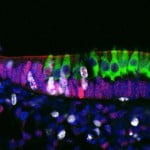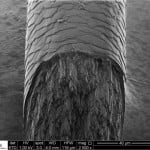Almost 40 million Americans suffer from hearing loss. Right now, there is no way to reverse this condition, largely because auditory hair cells, which sense sound and relay that information to the brain, do not regenerate.
A new study led by scientists at the University of Maryland School of Medicine (UM SOM) has found a key clue to how these hair cells develop. The current study identified a new role for a particular group of proteins, known as RFX transcription factors, in the development and survival of the hair cells.
“This discovery opens up new avenues, not only for understanding the genetics of hearing, but also, eventually for treating deafness,” said the principal investigator, Ronna P. Hertzano, MD, PhD, Assistant Professor of Otorhinolaryngology-Head & Neck Surgery at the UM SOM.
The study appeared in the latest issue of the journal Nature Communications. The work was done in collaboration with scientists at several institutions, among them Ran Elkon, PhD, an Assistant Professor and computational biologist at the Sackler School of Medicine at Tel Aviv University in Israel.
Hertzano and her colleagues used mice whose auditory hair cells glow with a green fluorescent protein, allowing the cells to be identified from other kinds of cells. They then used next generation sequencing — a state-of-the-art method to rapidly measure gene expression — to sequence and quantify the thousands of genes that are expressed in hair cells, in comparison with other cells in the ear. As they generated this catalogue of genes, they were searching for key regulators of genes for hair cells. Such regulators could help researchers eventually develop techniques to regenerate hair cells. The key regulator they identified were the RFX transcription factors.
The scientists then moved on to study mice which had been genetically altered so that their hair cells lacked two of the RFX transcription factors. In these mice, hair cells initially developed normally, but then died quickly, leading to rapid hearing loss. By three months of age, the mice were profoundly deaf.
Although the experiments were done in mice, Hertzano says that it is likely that these genes work similarly in humans. Eventually, she says, it might be possible to use our increased understanding of RFX transcription factor to treat hearing loss, by either protecting hair cells from death or fostering their growth. In addition, she and her colleagues think that they will be able to identify other genes that have an important role in hair cell function.
Hertzano first got interested in the genetics of hearing as an MD-PhD student at Tel Aviv University, and then pursued residency training at the UM SOM Department of Otorhinolaryngology, where she now works as a scientist and a surgeon whose practice is focused on diseases of the ear and hearing restoration.
The current paper appeared in conjunction with another paper published in Nature Communications, by Matthew W. Kelley, PhD, a neuroscientist at the National Institute on Deafness and Other Communication Disorders. Kelley and his team also used mice with fluorescent markers in different cells of the ear followed by next generation sequencing. Rather than analyzing groups of cells, they performed a comprehensive analysis of the genes that are expressed in the different cells at a single cell resolution. Their study is the first of its kind in the ear field and helps resolved the molecular aspects of the cellular complexity of the inner ear.
[SOURCE :-sciencedaily]



